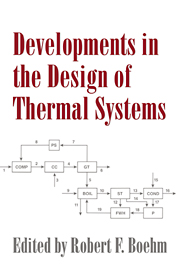Book contents
- Frontmatter
- Contents
- Preface
- Biographical sketches of the authors
- 1 Introduction and trends in the thermal design field
- 2 Computer-aided process design trends in the power industry
- 3 Automated design of chemical process plants
- 4 Thermophysical properties for design simulations
- 5 Introduction to Pinch Analysis
- 6 Second Law applications in thermal system design
- 7 Thermodynamic optimization of heat transfer and fluid flow processes
- 8 An introduction of thermoeconomics
- 9 Artificial intelligence in thermal systems design: concepts and applications
- Subject Index
- Author Index
9 - Artificial intelligence in thermal systems design: concepts and applications
Published online by Cambridge University Press: 23 September 2009
- Frontmatter
- Contents
- Preface
- Biographical sketches of the authors
- 1 Introduction and trends in the thermal design field
- 2 Computer-aided process design trends in the power industry
- 3 Automated design of chemical process plants
- 4 Thermophysical properties for design simulations
- 5 Introduction to Pinch Analysis
- 6 Second Law applications in thermal system design
- 7 Thermodynamic optimization of heat transfer and fluid flow processes
- 8 An introduction of thermoeconomics
- 9 Artificial intelligence in thermal systems design: concepts and applications
- Subject Index
- Author Index
Summary
Artificial intelligence and expert systems
AI (for an exact definition, see Section 9.3.2.1) is in reality a cumulative denomination for a large body of techniques that have two general common traits: they are computer methods and they try to reproduce a nonquantitative human thought process. General AI topics are not addressed here. For information on this topic see the various monographs giving fundamental information, including Charniak and McDemmott (1983), Drescher (1993), Rich (1983), and Widman, Loparo, and Nielsen (1989).
The applications we will deal with in this chapter are related to a smaller subset of general AI techniques: the so-called knowledge-based systems, also called expert systems. Referring the reader to Section 9.3.2.2 for definitions, will say only that an ES is an AI application aimed at the resolution of a specific class of problems. Neither a computer nor an ES can think: the ES is a sort of well-organized and well cross-referenced task list, and the computer is just a work tool. Nevertheless, ES (and in general AI techniques) can result in efficient, reliable, and powerful engineering tools and can help advance qualitative engineering just as much as numerical methods have done for quantitative engineering.
ESs have many benefits. They provide an efficient method for encapsulating and storing knowledge so that it becomes an asset for the ES user. They can make knowledge more widely available and help in overcoming shortages of expertise. Knowledge stored in an ES is not lost when experts are no longer available.
- Type
- Chapter
- Information
- Developments in the Design of Thermal Systems , pp. 234 - 278Publisher: Cambridge University PressPrint publication year: 1997
- 3
- Cited by



